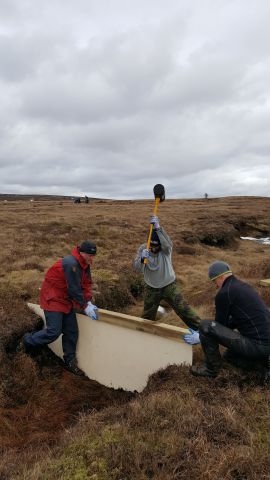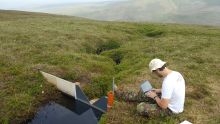By Dr Emma Shuttleworth, University of Manchester
The Upland Environments Research Unit at the University of Manchester has been working closely with Moors for the Future Partnership over the last decade to produce an empirically grounded evidence base to demonstrate the multiple benefits of blanket peat restoration. The primary aims of peatland restoration works are often to stabilise the landscape, raise water tables and increase biodiversity, but the restoration of natural processes may also have a positive impact on flood risk. Our recent work has focussed on assessing the degree to which natural flood management (NFM) may be one of the many benefits that peatland restoration can provide.
In 2011, 84 ha of blanket peat on the Kinder Plateau was restored through a combination of bare peat revegetation and gully blocking as part of the Defra funded Making Space for Water project. We monitored three small catchments both before and after the restoration works took place. One catchment was revegetated, another was revegetated and gully blocked, and the final catchment was left bare so we could quantify any changes relative to doing nothing. We found that revegetation reduces peak flows by a quarter and doubles the time it takes for flow to reach its peak. We also found that the addition of gully blocks doubles the effects of vegetation alone. Crucially, we found that the volume of water running off the hillslope is unchanged. This is important for two reasons. Firstly, there was concern that raised water tables as a consequence of the restoration work would reduce the landscapes ability to store water during storms, but there is no evidence of this. Secondly, it tells us something about the mechanism by which the restoration interventions impact stormflow. As there is no change in storage following restoration, we argue that the vegetation and gully blocks have slowed the flow of water across the landscape by increasing surface roughness. This delays the release of water from the uplands and reduces peak stream flow during storms, and if implemented widely could alleviate the chance of flooding downstream. Earlier this year we published two free to download papers detailing our findings. The first, 'Restoration of blanket peat moorland delays stormflow from hillslopes and reduces peak discharge', focusses on the impact of restoration on stormflow discussed above, while the second, 'Trajectories of ecosystem change in restored blanket peatlands', frames the NFM benefits of blanket peatland restoration within the wider context of ecosystem services recovery.
We are continuing to build on our work on Making Space for Water through the NERC funded Protect-NFM. Protect-NFM aims to optimise multi-benefit restoration work for natural flood management and demonstrate that upland restoration offers a low-cost way to reduce the risk of flooding in vulnerable rural communities. We are continuing our experimental work to assess the impact of restoration of Sphagnum cover, different types of gully blocking, and establishment of upland woodlands on stormflow, as well as investigating the long term evolution of restoration approaches. The data will be used to develop user-friendly, open-source computer models to optimise combinations of interventions, which will be shared with practitioners. Our preliminary results suggest that NFM benefits are maintained (and may increase!) as restored systems mature and that Sphagnum reintroduction has the potential to further slow the flow of water at revegetated sites. The project runs to the end of 2021, so follow us on Twitter for updates as we find out more.
Dr Emma Shuttleworth, University of Manchester
Making space for water - report
Making space for water- restoration techniques
References:
Alderson et al. (2019) Restoration of blanket peat moorland delays stormflow from hillslopes and reduces peak discharge. Journal of Hydrology X
Alderson et al. (2019) Trajectories of ecosystem change in restored blanket peatlands. Science of the Total Environment (665) p785-796


